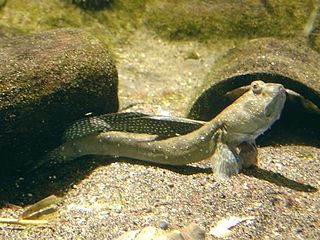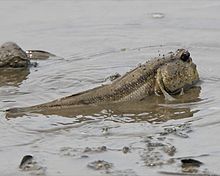
Amphibious fish are fish that are able to leave water for extended periods of time. About 11 distantly related genera of fish are considered amphibious. This suggests that many fish genera independently evolved amphibious traits, a process known as convergent evolution. These fish use a range of methods for land movement, such as lateral undulation, tripod-like walking, and jumping. Many of these methods of locomotion incorporate multiple combinations of pectoral-, pelvic-, and tail-fin movement.

Mudskippers are any of the 23 extant species of amphibious fish from the subfamily Oxudercinae of the goby family Oxudercidae. They are known for their unusual body shapes, preferences for semiaquatic habitats, limited terrestrial locomotion and jumping, and the ability to survive prolonged periods of time both in and out of water.

Canh chua is a Vietnamese sour soup indigenous to the Mekong Delta region of Southern Vietnam. It is typically made with fish from the Mekong River Delta, pineapple, tomatoes, and bean sprouts, in a tamarind-flavored broth. It is garnished with the lemony-scented herb ngò gai, caramelized garlic, and chopped scallions, as well as other herbs, according to the specific variety of canh chua; these other herbs may include rau răm, ngò om, and rau quế. It can be served alone, with white rice, or with rice vermicelli. Variations can include prawns, squid, spare ribs, fish cakes and quail eggs.

Periophthalmus is a genus of fish in the family Oxudercidae that is native to coastal mangrove woods and shrubland in the Indo-Pacific region, except for P. barbarus, which lives on the Atlantic coast of Africa. It is one of the genera commonly known as mudskippers. Periophthalmus fishes are remarkable for using limited terrestrial locomotion and jumping to live temporarily out of water to feed on insects and small invertebrates. All Periophthalmus species are aggressive and territorial.
Zappa confluentus, the New Guinea slender mudskipper, is a mudskipper endemic to New Guinea, where it is only known from the lower parts of the Fly, Ramu Rivers. It is found on mudflats adjacent to turbid rivers. This species can reach a length of 4.4 centimetres (1.7 in) SL.

The giant mudskipper is a species of mudskipper native to the tropical shores of the eastern Indian Ocean and the western Pacific Ocean where it occurs in marine, brackish and fresh waters. It is most frequently found along muddy shores in estuaries as well as in the tidal zones of rivers. It lives in burrows that it constructs in higher grounds of the intertidal zone, which are typically filled with both water and air. During warmer seasons, it is typically active outside of its burrow during low tide. It is an obligate air-breather and is capable of drowning without sufficient access to air, so it spends much of its life on land.

The Atlantic mudskipper is a species of mudskipper native to fresh, marine, and brackish waters of the tropical Atlantic coasts of Africa, including most offshore islands. The Greek scientific name Periophthalmus barbarus is named after the eyes that provide the Atlantic mudskipper with a wide field of vision. The Atlantic mudskipper is a member of the genus Periophthalmus, which includes oxudercine gobies that have one row of canine-like teeth.

The barred mudskipper or silverlined mudskipper, is a species of mudskippers native to marine, fresh and brackish waters from the African coast of the Indian Ocean, to the Marianas and Samoa in the western Pacific Ocean, and from the Ryukyus south to Australia. This species occurs in mangrove forests and nipa palm stands and can cross surfaces of mud while out of the water. This species can reach a length of 19 centimetres (7.5 in) TL. It can also be found in the aquarium trade.
Parasites of the barred mudskipper include Acanthocephalan larvae and the small Opecoelid Digenean parasite in the intestine and described from fish collected in New Caledonia.

Apocryptes bato is a species of mudskipper native to India, Bangladesh and Myanmar where it can be found in tropical rivers, estuaries and coastal waters of the Indian Ocean. This species can reach a length of 26 centimetres (10 in) TL. It is of minor importance to local commercial fisheries. It is currently the only known member of its genus.

Boleophthalmus is a genus of mudskippers native to the Indian Ocean and the western Pacific Ocean.

Apocryptodon is a genus of gobies in the family Oxudercidae, native to the Indian Ocean and the western Pacific Ocean.

Oxuderces is a genus of fish in the family Gobiidae native to fresh and brackish waters of coasts of the Indian and Pacific Ocean.
Platygobiopsis is a genus of gobies native to the western Pacific Ocean.

Scartelaos is a genus of gobies native to the coasts of the Indian Ocean and the western Pacific Ocean.
Darwin's mudskipper is a relatively newly discovered mudskipper in 2004, so little is known about it. It is a brackish water ray-finned fish found in Australia along mud banks never far from mangrove trees. It is in the goby family Gobiidae. It is named after Charles Darwin because the holotype was collected in Darwin Harbour. Its greatest distinguishing characteristic from other mudskippers is its greatly reduced first dorsal fin in both sexes.

Oxudercidae is a family of gobies which consists of four subfamilies which were formerly classified under the family Gobiidae. The family is sometimes called the Gobionellidae, but Oxudercidae has priority. The species in this family have a cosmopolitan distribution in temperate and tropical areas and are found in marine and freshwater environments, typically in inshore, euryhaline areas with silt and sand substrates.

Periophthalmodon freycineti, the pug-headed mudskipper, is a species of mudskipper from the subfamily Oxudercinae of the gobiiform family Oxudercidae. It distribution extends from the Philippines through eastern Indonesia, Papua New Guinea and northern Queensland. Its habitat is tidal creeks, mud banks and inlets where it is a predator on small fish, crabs and other invertebrates such as insects. The specific name honours the French explorer Louis de Freycinet (1779-1841), the leader of the expedition on which the type was collected.

Periophthalmodon septemradiatus is a species of mudskipper found along tropical shorelines of the eastern Indian Ocean where it occurs in marine, brackish and fresh waters from India to Mekong Delta Vietnam, Indonesia. It is found along in estuaries as well as in the rivers.

Boleophthalmus pectinirostris, commonly known as the great blue spotted mudskipper, is a species of mudskipper native to the north-western Pacific Ocean. It can be found on the coastlines of Japan, eastern China, Sumatra, Malaysia, Taiwan and the Korean Peninsula.

Boleophthalmus boddarti, commonly known as Boddart's goggle-eyed goby, is a species of mudskipper native to the Indo-Pacific, and the type species of the genus Boleophthalmus.















